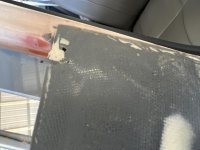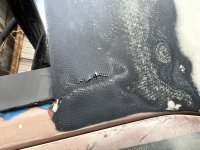Bill Boyd
Well Known Member
I have some cracking going on in the mold-in-place fairing at the base of the windscreen. A friend nearby (not a member here) has reported the same on his -10. This is cracking of the plies over the outside lower corners of the windscreen and has taken a year or better to appear. Thankfully, my bird is not yet painted; my friend's is.
I'm looking for suggestions on how to do the repair when the hangar warms up a bit this month. Hoping to shoot Stewart Eko this spring and this needs to be fixed first. Thanks, Dan and everybody.
Photos are rotated 90 for some reason - sorry.
I'm looking for suggestions on how to do the repair when the hangar warms up a bit this month. Hoping to shoot Stewart Eko this spring and this needs to be fixed first. Thanks, Dan and everybody.
Photos are rotated 90 for some reason - sorry.






